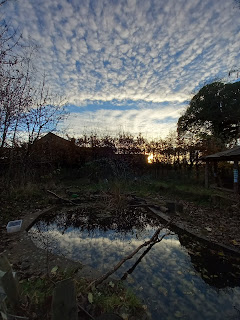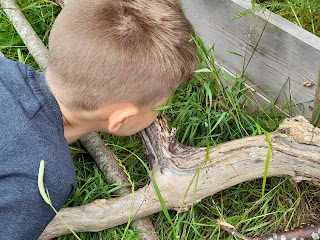Campfire
A campfire is a treat at Chartham.
We don't have one every session even when the weather is cold. There are a few reasons for this, the main one being ratios! when we have a campfire I cannot leave the fire pit area, which has at times meant one TA left to supervise 20+ children!
Then there's the time constraint. Often I have two classes in a morning, each session lasting approximately 60 minutes. This may mean keeping a fire going constantly as dampening it down after session one will make setting one for session two difficult!
There is also the cost. With 16 classes a week we would need to buy in a minimum of £10 of logs a week, plus kindling... it adds up quickly. Yes, we have some trees and some woodland, but not enough to sustain campfires all week, all term, all year.
Importantly, there are other considerations. To the environment for one, and to the participants also. There is a lot of study surrounding the negative effects of smoke inhalation.
This US article by Kurt Repanshek in National Parks Traveller talks about campfires in National Parks and explains the concerns. A more scientific article can be found here at Woodsmokepollution.org
If you have any kind of respiratory condition, even mild asthma, there is a risk of aggravating the illness. Inhaling wood smoke, even for a short period of time, can start the chain reaction of breathing difficulties that requires an ambulance.
As lovely and cosy as a fire is in winter, as hypnotic as flames can be to watch, and as important as it is to teach fire safety and respect, most of us have experienced stinging eyes, a need to cough, a bad taste in our mouth, and even a runny nose.
Wood smoke contains tiny particles, millions of the things, that you breathe in when around smoke. These enter your lungs and affect your entire respiratory system even if you have no underlying conditions. For those who do have some form of illness, this can be dangerous.
Obviously, the medical needs of anyone in your session will be on your records and you will aware of who is vulnerable. There are a few precautions you can take to mitigate the inhalation of these particles.
One of the most important things is to know what wood you are burning. Seasoned logs are best, anything new or damp will produce more smoke, and some kinds of wood naturally produce chemicals you wouldn't want floating around. Offcuts, treated wood, anything with paint splashes etc are likely to also be giving off 'toxic' fumes. This can lead to headaches, occasionally nausea (and vomiting) and if you have very small children the reactions can be quite severe.
There are lots of infographics out there to help (like this one from Gr8fires) which should help, and come in a range of complexity!
Try to use small logs and kindling if possible. If the fire will be lit for a long time aim for logs less than 15/16cm in diameter. The smaller the better! This can concentrate the heat and make the fire burn hotter, it also burns faster so make sure you have enough fuel! Kindling usually produces a lot less smoke than logs when burned.
I'm sure I don't have to save to avoid accelerants! On a very damp or difficult day, if you need a firelighter use the minimum and ensure it has burned away before letting children sit close. Make sure you are aware of the content of the firelighters, the ingredients may be 'safe' but ought to be listed on your RA in case of any reaction.
We all head inside in a gale, but if it is at all windy remember the fire can burn hotter, it can also spread the smoke around at a lower level rather than blow it away
Please remember that the smoke is not the only thing you are breathing in. The air around the fire is warm/hot. Inhaling heated air is not good for the tissues of the lungs. It's bad for an adult and worse for developing children.
Sitting close to toast a Marsh Mallow or roast some bread on a stick could mean gulping in a volume of super heated air.
All of this is food for thought.
I still have campfires, and the children sit by them to toast a mallow! I use bought wood. We do this only once a Term. The children are seated two metres from the fire, and only come in close for a few minutes. Once everyone has had their turn we let the fire burn out. This means I am free to join in the session AND that the fire is only lit for about 20 minutes.
I also only have a fire big enough for our needs! We are toasting a mallow... not having a spit roast! We do not need HUGE flames!
I think the campfire is a great learning tool. I have many children who come to a session having made a fire at home in the grate or have helped in the garden with burning leaves, and most frequently, those who have made one in a video game! They all think they 'know' fire. All are surprised by its heat!
This week a very wet parachute canopy trapped a lot of smoke above our heads. The vent did allow much to escape, but the weight of the fabric brought lowered the roof a little and it felt more like an indoor fire than an outdoor one.
Luckily there was a breeze and a 2 metre level from the ground upwards which was very clear. The fire was lit for 30 minutes. 20 minutes with the children present but 2 metres away, and each child was alongside it for 60 - 90 seconds (in groups of 3). They sat south of the fire to toast their Marshmallow while the breeze blew the flames north.
The fire burned hot and fast and burned itself out just as the children were ready to explore elsewhere. Timing takes a lot of practice and will never be mastered!I HAVE taught children to use a flint and steel.
We DO talk about only using dry wood.
We learn NEVER burn wrappers or tissues etc on the campfire.
We ensure no one ever THROWS something (even a twig) onto the fire.
We respect the flame, the heat.
We make sure fire blankets, buckets of sand and water, fire gloves, and even 'Stop, Drop, & Roll' are understood.
We're very good at 'teaching' fire safety, but how much attention do we pay to smoke safety?
If you have a fire burning all day, please do look into the research regarding breathing in smoke. You don't need to stop but I would recommend it is on your Risk Assessment and your Risk Benefit Assessment if it isn't already.
Inhaling particles is not good no matter how healthy you are!
My RA needs updating to ensure everything is as safe as I can make it and that it informs what we buy and use in the future.
Guess what I'll be doing over half term!?
(Part 2, Campfire and the environment is here)



.png)







Comments
Post a Comment